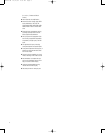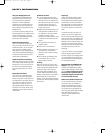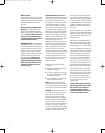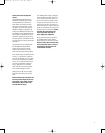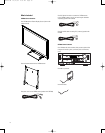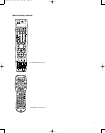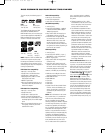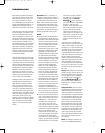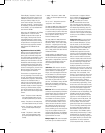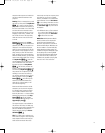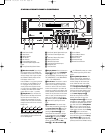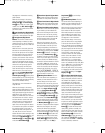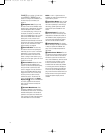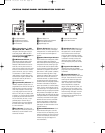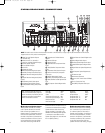
14
Plasma Display. Composite, S-video and
component video monitor outputs on the
CVR700 are provided as a means of con-
necting an auxiliary display only. On-
screen status messages, and all digital
video post-processing – including scaling,
de-interlacing, and upconversion features
of the CVR700 – are only available when
used with the CVPD50.
When using the CVR700 with the CVPD50
display, there is no need to use the
CVR700’s component video outputs. All
video signals, including those from the
internal DVD/changer as well as those
originating with external source devices,
are upconverted to the digital format uti-
lized by the single proprietary interface
cable between the CVR700 and the
CVPD50.
High-Definition Television (HDTV):
HDTV is a form of digital television that
advances picture quality by leaps and
bounds over conventional analog televi-
sion. HDTV signals are broadcast in a dig-
ital format that compresses the signal,
allowing far more information to be sent.
Broadcasters take advantage of the addi-
tional bandwidth by offering high-resolu-
tion images containing millions more pix-
els than an analog picture, the end result
being an image so sharp it looks more
like a photograph than television.
The resolution of a digital video signal
can vary, depending on the number of pix-
els used, and whether the image frames
are interlaced or progressive. Conventional
television uses interlaced frames, in
which first the odd horizontal pixels are
scanned, then all of the even pixels are
scanned to display one frame. Progressive
scanning, as described below
, displays
all of the horizontal lines of pixels in one
pass. These are the common digital video
formats:
• 480i – The picture is 704 x 480 pixels,
sent at 60 interlaced frames per sec
-
ond (30 complete frames per second).
• 480p – The picture is 704 x 480 pixels,
sent at 60 complete frames per second.
• 720p – The picture is 1280 x 720 pix-
els, sent at 60 complete frames per
second.
• 1080i – The picture is 1920 x 1080
pixels, sent at 60 interlaced frames
per second (30 complete frames per
second).
• 1080p – The picture is 1920 x 1080
pixels, sent at 60 complete frames per
second.
The “p” and “i” designations stand for
“progressive” and “interlaced.”
The 480p and 480i (when digital) formats
are called the SD (standard-definition)
formats, and 480i is the digital equivalent
of a normal analog TV picture. When ana-
log TV shows are upconverted and broad-
cast on digital TV stations, they are
broadcast in 480p or 480i.
The 720p, 1080i and 1080p formats are
HD (high-definition) formats. When you
hear about “HDTV,” this is what is being
discussed – a digital signal in the 720p,
1080i or 1080p format. If your HD source
allows you to choose a picture resolution,
set it to 720p, which works best with the
CVR700 and CVPD50.
Strictly speaking, the 480p format is con-
sidered ED (enhanced definition). However,
the JBL Cinema Vision system processes
480p signals as high-definition, and when
referring to high-definition signals, we
will be talking about 480p or better
images.
JPEG Files: JPEG stands for the Joint
Photographic Experts Group, which devel-
oped a standard for compressing still
images, such as photographs. JPEG files
may be created on a personal computer
by importing images from a digital cam-
era, or scanning printed photographs.
These files may be burned onto a com-
pact disc. The CVR700 is among the DVD
players that are capable of recognizing
JPEG files and enabling you to view them
on your video screen.
MP3 Files: MP3 is an audio compression
format that was developed by the Motion
Picture Experts Group as an adjunct to the
MPEG-1 video compression format. A
number of encoding software programs
are available for transferring CDs and
other audio programs into the MP3 for
-
mat. The main benefit of MP3 is that it
reduces the size of audio files consider
-
ably, depending on the amount of com-
pression selected during the encoding
process, enabling you to store many more
songs on one compact disc than in the
standard audio CD format. The CVR700 is
capable of playing MP3 files and display-
ing the filenames on screen.
Multiple Angle: DVDs have the capabil-
ity to show up to four different views of
the same scene in a program. When a
disc is encoded with multiple-angle infor-
mation, pressing the
Angle Button
E
will enable you to switch
between these different views. Note
that, at present, few discs take advan-
tage of this capability and, when they do,
the multiple-angle technology may only
be present for short periods of time with-
in the disc. Producers will usually insert
some sort of icon or graphic in the picture
to alert you to the availability of multiple-
angle scenes.
Progressive scan: If you are using the
CVR700 with the CVPD50 display, and
with no external DVD players, you may
skip this section, as the internal DVD
player outputs a digital video signal that
is passed directly to the CVPD50 using
the proprietary interface cable. The
CVR700 offers progressive scan video
outputs for use with compatible high-res-
olution televisions and projectors. Before
DVD, no consumer medium could store,
transmit or display video with full resolu-
tion. To conserve bandwidth, analog com-
pression (interlacing) is employed: first
the odd-numbered lines of a frame are
displayed, followed by the even-num-
bered lines. The result is that only half of
the video image is drawn at one time; the
viewer’s brain must reassemble the com-
plete image. This is acceptable, if the
monitor is not too large and if there is not
too much motion in the image. Large dis-
plays and fast-moving images reveal the
limitations of this system. Thanks to
DVD’
s immense data capacity, images are
now stored intact (progressively), so that
all the lines in each frame (odd and even)
are shown at the same time. But because
most TVs cannot handle a progressive
signal, all current DVD players generate
an interlaced output for compatibility
. The
CVR700 is among the select few DVD
players with true progressive scan video
output for use with compatible TVs and
CRT projectors and with all plasma, LCD
and DLP display devices via the compo
-
nent video output. The result is 40%
greater light output than a conventional
TV and a stunningly detailed high-defini-
tion image, along with an almost com
-
plete absence of visible scanlines and
motion artifacts. The CVR700’s sophisti-
cated pixel-by-pixel processing is a major
advancement over the previous genera-
tion’s line-by-line processing, bringing out
even greater detail in your favorite video
presentations. Of course, traditional
Y/Pr/Pb component video, S-video and
33
3
4
35
3
6
37
3
8
39
4
0
41
42
43
44
45
46
47
48
49
50
51
52
53
54
55
56
57
38
39
4
0
41
31
3
2
30
28
29
25
2
6
27
2
8
29
30
24
2
3
22
2
1
20
3
1
3
7
36
3
5
34
33
3
2
3
1
37
3
6
3
5
34
33
3
2
48
49
5
0
51
47
4
6
4
5
44
43
4
2
1 2 3 4 5
6
7
8 9 10 11 12
13 14 15 16 17 18
1
9
2
0
2
1
2
2
2
3
2
4
25 26 27 28 29 30
31 32 33 34 35 36
37 38 39 40 41 42
43 44 45 46 47 48
CVR700 OM 12/17/04 4:23 PM Page 14



